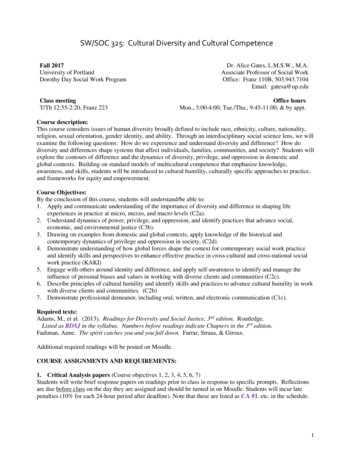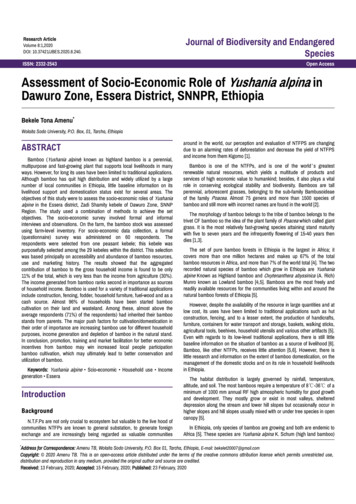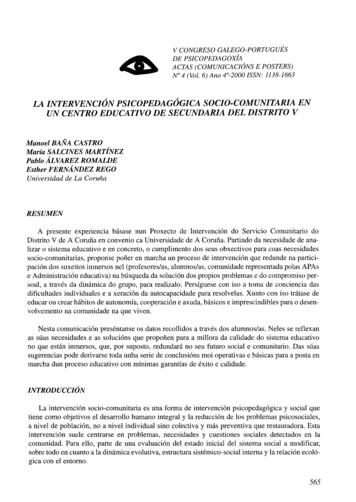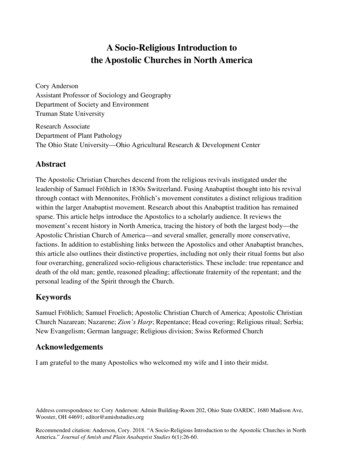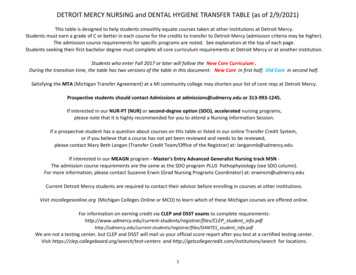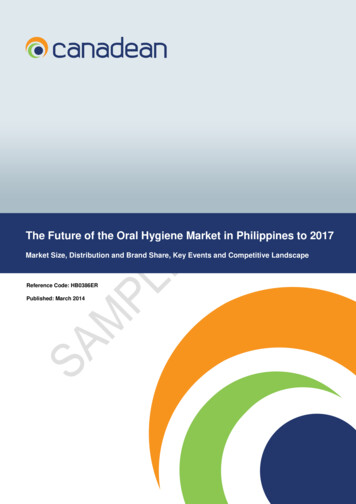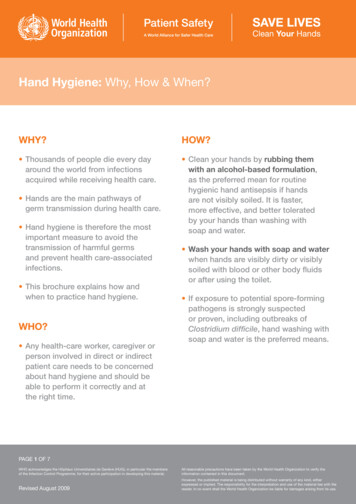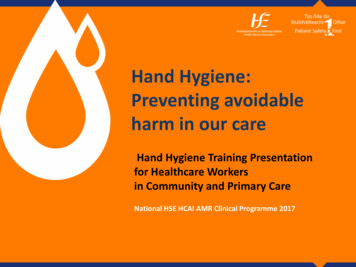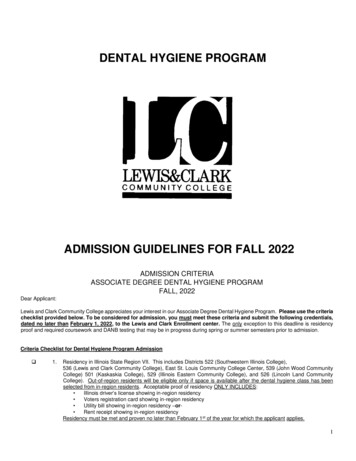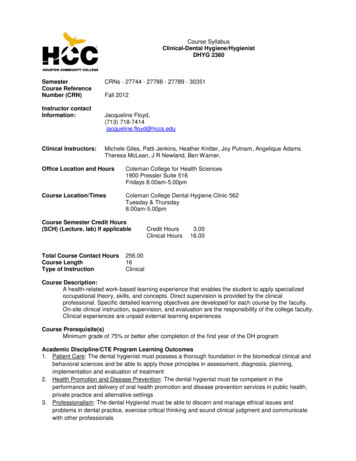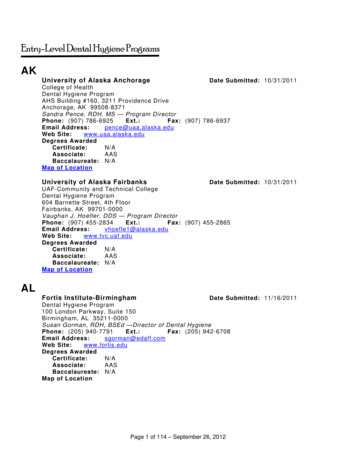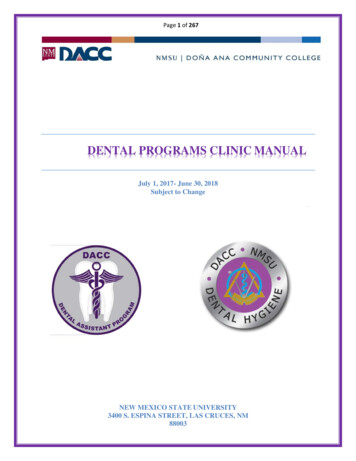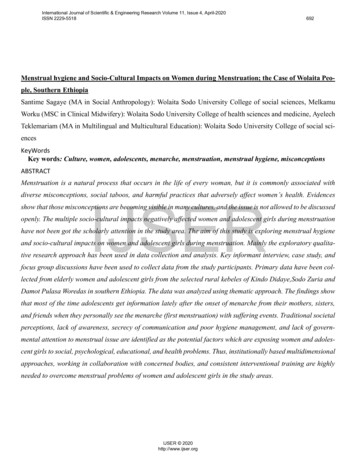
Transcription
International Journal of Scientific & Engineering Research Volume 11, Issue 4, April-2020ISSN 2229-5518692Menstrual hygiene and Socio-Cultural Impacts on Women during Menstruation; the Case of Wolaita People, Southern EthiopiaSantime Sagaye (MA in Social Anthropology): Wolaita Sodo University College of social sciences, MelkamuWorku (MSC in Clinical Midwifery): Wolaita Sodo University College of health sciences and medicine, AyelechTeklemariam (MA in Multilingual and Multicultural Education): Wolaita Sodo University College of social sciencesKeyWordsKey words: Culture, women, adolescents, menarche, menstruation, menstrual hygiene, misconceptionsABSTRACTMenstruation is a natural process that occurs in the life of every woman, but it is commonly associated withIJSERdiverse misconceptions, social taboos, and harmful practices that adversely affect women’s health. Evidencesshow that those misconceptions are becoming visible in many cultures, and the issue is not allowed to be discussedopenly. The multiple socio-cultural impacts negatively affected women and adolescent girls during menstruationhave not been got the scholarly attention in the study area. The aim of this study is exploring menstrual hygieneand socio-cultural impacts on women and adolescent girls during menstruation. Mainly the exploratory qualitative research approach has been used in data collection and analysis. Key informant interview, case study, andfocus group discussions have been used to collect data from the study participants. Primary data have been collected from elderly women and adolescent girls from the selected rural kebeles of Kindo Didaye,Sodo Zuria andDamot Pulasa Woredas in southern Ethiopia. The data was analyzed using thematic approach. The findings showthat most of the time adolescents get information lately after the onset of menarche from their mothers, sisters,and friends when they personally see the menarche (first menstruation) with suffering events. Traditional societalperceptions, lack of awareness, secrecy of communication and poor hygiene management, and lack of governmental attention to menstrual issue are identified as the potential factors which are exposing women and adolescent girls to social, psychological, educational, and health problems. Thus, institutionally based multidimensionalapproaches, working in collaboration with concerned bodies, and consistent interventional training are highlyneeded to overcome menstrual problems of women and adolescent girls in the study areas.IJSER 2020http://www.ijser.org
International Journal of Scientific & Engineering Research Volume 11, Issue 4, April-2020ISSN 2229-55181.693INTRODUCTIONThe beginning of menarche (the first menstruation) is one of the most important phenomena occurring among thegirls during the adolescent years (Archana Patkar, 2011), and it is part of the female reproductive cycle that startswhen girls become sexually mature at the time of puberty ((Pandey: 2014, Teklemariam: 2014:189).Although menstruation is a natural process that occurs in the life of every woman, it is commonly associated withdiverse misconceptions, social taboos, and harmful practices that adversely affect women’s health. Evidencesshow that those misconceptions are becoming visible in many cultures, and the issue is not allowed to be discussedopenly (Dasgupta and Sarkar: 2008, Umeora OUJ: 2008. Water Aid Report: 2010, Bano and Al Sabhan: 2015).Obviously, from this we can understand that those misconceptions together with traditional beliefs and normscreate unjust segregation of women. Besides, it makes menstruation become the secret agenda and somethingimmoral to communicate and discuss openly.IJSERActually, the transition from childhood to adulthood occurs during adolescence period which is characterized bymajor biological changes like physical growth, sexual maturation and psycho-social development. However, inthis transition period, girls first experience menstruation and related problems which is marked by feelings ofanxiety and eagerness to know the issue (Shambhag et al: 2012), and also the young girls describe the onset ofmenarche as a shocking or fearful event (Pandey: 2014).There are different beliefs and community defined restrictions for menstruating women in many cultures. Forinstance, Igbo women rarely discuss menstruation, and show major displeasure at the introduction of the subject(Umeora and Egwuatu 2008), and in Hindu culture women are not allowed to pray or fast nor is she allowedtouching the holy book and temple (Pandey: 2014). Menses is also associated with silence, shame, social taboosand restrictions in many cultures. Moreover, menstruating women are considered as dirty, impure, unclean, andunfit (Archana Patkar: 2011, Water Aid Report: 2010). On the other side, treating women as dirty and restricting discussion on menstrual issue with their family members would have adverse health impacts on women (Banoand Al Sabhan 2015). These can be taken as the practical implications for the existence of social exclusions whichundermine women and accelerate hygiene management and associated health problems.Reproductive tract infections, which has become a silent epidemic that devastates women's life is closely interrelated with poor menstrual hygiene. Therefore, proper menstrual hygiene and correct perceptions and beliefs canprotect the women from this suffering (Shambhag et al: 2012). Menstrual hygiene management has not receivedadequate attention in the reproductive health sectors in developing countries. In Africa the practice of menstrualIJSER 2020http://www.ijser.org
International Journal of Scientific & Engineering Research Volume 11, Issue 4, April-2020ISSN 2229-5518694hygiene management is still poor and the issue is under estimated. Due to poor menstrual hygiene managementthe adolescent girls are exposed for reproductive tract infection, school absenteeism and increase school dropoutrate (Teklemariam: 2014).The girls’ inadequate understanding of menstrual process prior to the onset of menarche causes panic, anxietyand embarrassment. Their poor understanding of menses before its first onset makes them to be frightened, anxious and embarrassed with situations (Anne Mutunda, 2013). However, increased knowledge about menstruationright from childhood may escalate safe practices and may help in mitigating the suffering of women (Shambhag et al:2012). Moreover, knowledge about menstrual hygiene was the most influencing factors for the practice of menstrual hygiene (Teklemariam 2014)Majority of the girls intended to seek advice from their mother for any menstrual practices, problems, nutrition,and any health problems The most common source of information was the mother. All mothers irrespective oftheir educational status should be taught to break their inhibitions about discussing with their daughters regardingIJSERmenstruation much before the age of menarche. (Shambhag et al: 2012).There are many problems attributed to menstrual cycle. For instance: First, Premenstrual Syndrome (PMS):- Thisis distressing physical, Behavioral and psychological symptoms, in the absence of organic or underlying psychiatric disease (Taylor, 2005). Second, Premenstrual Dysphoric Disorder (PMDD):- it is severe form of PMS inwhich symptoms of anger, irritability, and/or internal tension are prominent and there was significant functionalimpairment. Third, other Menstrual Cycle problems include heavy flow, cramps, anovulatory cycle and irregular,absent or long cycles (Huo et al, 2007; Klatzkin et al, 2010); Taylor, 2006).Menstrual hygiene management is a necessity, but it is the challenging issue for the life of adolescent girls. Itneeds accurate and adequate information to manage appropriately in hygienic and discreet ways (Guya et al:2014:27). It is believed that providing information and educating girls on menstrual hygiene at an early age beforethey reach puberty and continue throughout adolescence would better prepare them emotionally and psychologically for menstrual issues including hygienic management systems (Guya et al: 2014:27).Indeed, to live healthy, productive and dignified lives, women and adolescent girls have to manage menstrualbleeding effectively. Neglecting menstrual hygiene and management negatively affects girls’ education, health,and the potential of achieving development goals (Water Aid Report 2010). Thus, menstrual hygiene managementneeds holistic approach taking into account the voice and space to talk, adequate water, privacy, facilities forwashing and disposal of used sanitary pads (Teklemariam: 2014).IJSER 2020http://www.ijser.org
International Journal of Scientific & Engineering Research Volume 11, Issue 4, April-2020ISSN 2229-5518695There are scholars who previously conducted their studies on the issues of menstruation in different societies indifferent parts of the world. To mention some, Guya et al (2014) on University students of Tanzania, Bano andAl Sabhan (2015) on University female students in Soudi Arabia, K. Kamaljit et al (2012) on secondary schoolstudents of Amritsar, Punjab, India, and Teklemariam Ketema (2014) on high school students in Amhara regionalstate of Ethiopia. Their studies were emphasized on the perceptions, social values, and knowledge level of adolescents towards menstrual hygiene management. However, there exist the multiple missing points in those studies in their focus and selection of study population, because they are mainly focusing on the high school andUniversity students as their study population. In this case, the women and adolescent girls out of the school havenot been taken into account and the multiple socio-cultural problems which lay the casual grounds for menstrualproblems were kept intact untouched.Taking into account the above gaps in the previous studies, the purpose of this study is to explore the sociocultural impacts on women and adolescent girl’s elementary school students and women and girls out of schoolin the rural areas of the study. This study has not purposely given emphasis to the high school and UniversityIJSERstudents because it is believed that high school and University students might have better access to informationawareness about menstruation since they have at least course based lessons and practical experiences of menarchein their actual life. Thus, this study gives more emphasis to the elementary students and uneducated rural adolescent girls in rural areas of the study.In fact, though there are enormous problems related with menstruation that affect the life of women in reproductive age, the case of menses is did not get due attention in government’s health care systems. On the other hand,the society also did not understand the adverse effects of cultural values on women during menstruation. Therefore, this study strives to explore the societal conception of menstruation and the personality of women and adolescent girls during menstruation. This study has also further investigated the socio-cultural impacts on adolescentgirls and women in menstrual period in the context of Wolaita people.IJSER 2020http://www.ijser.org
International Journal of Scientific & Engineering Research Volume 11, Issue 4, April-2020ISSN 2229-55182.696MATERIALS AND METHODS2.1 Research ApproachThis study has employed the exploratory qualitative approach in both data collection and analysis to meet theobjectives effectively. This approach employed with the intention to intensively explain the beliefs and culturalnorms people traditionally associate with menstruation and the personality of women and adolescent girls. It isbelieved that qualitative approach is more preferable than quantitative approach to further explain the impacts ofsuch traditional beliefs and cultural norms. In addition to the investigators three female sociology, anthropologyand midwifery degree graduates i.e. one from each departments were involved in data collection from the field.Data collected from the field have been analyzed qualitatively by thematic approach to explore the socio-culturalimpacts on women and adolescents girls during menstruation.2.2 Data SourcesPrimary SourcesIJSERPrimary data have been collected from elderly women and adolescent girls from the selected rural kebeles ofKindo Didaye,Sodo Zuria and Damot Pulasa Woredas in southern Ethiopia. Adolescent girls and elderly womenfrom the selected woredas and rural kebeles were potential sources of primary data. In selecting informants, researchers take into account the informants’ knowledge level to the cultural tradition of the Wolaita people andadolescents practical life experience of menses. Generally, researchers have used focus group discussions (FGDs),key informant interviews, and case study methods to collect primary data.Secondary SourcesSecondary data were collected from relevant books, Masters Theses, articles, and other published and unpublishedsources. The secondary data enabled the researchers to identify the research gaps in previous studies and existingmisconceptions regarding menstruation among different societies in different parts of the world.2.3 Methods of Data CollectionFocus Group Discussion (FGD)Focus group discussion (FGD) is one of the crucial techniques of data collection in social sciences in general andqualitative studies in particular. Hence, in this study, FGD has played indispensable roles to generate reliable dataabout the societal conception of menstruation and the very existence socio-cultural impacts on adolescent girlsand women during menstruation. The selected members/discussants were encouraged to discuss, generate, andIJSER 2020http://www.ijser.org
International Journal of Scientific & Engineering Research Volume 11, Issue 4, April-2020ISSN 2229-5518697share their ideas to one another freely. Researchers conducted two FGD sessions with seven selected members/discussants under each session. The first FGD has been conducted with elderly women in Kindo DidayeWoreda and the second FGD has been conducted with adolescent girls in Damot Pulasa Woreda. FGDs weretaken place by local language i.e. Wolaitigna and were translated to English and narrated intensively.InterviewsIn this study, interview is believed to be the important method to assess the conceptions, belief, and experiencesof informants about menstruation. Key informant interview have been conducted with selected adolescent girlsand elderly women. The unstructured interview guidelines questions were used as the crucial tool of data collection. As pointed out by Kothari (2004: 98), these unstructured interview questions give more freedom for inclusion of emerging new questions and exclusion of some questions based on the ongoing situations in the field. Weconducted four key informant interviews. Interviews were taken place by local language i.e. Wolaitigna and weretranslated to English and narrated intensively.IJSERCase Study/Life history ApproachThis is one of the methods of data collection in anthropological and sociological studies in which the cases/lifehistories which need intensive analysis were collected from the field. It helps researchers to infer substantialexperiences, encounters, life situations, and perceptions of a particular person in his or her life time. The especialcases/life histories of adolescent girls and elderly women were captured for evidential support of our explanationand better understanding of menstruation and women’s life in the socio-cultural context of Wolaita people. Thecollected cases/life histories from individuals were translated from local language to English and narrated intensively.3. RESULTS AND DISCUSSION3.1 Local Definition and Conceptualization of MenstruationThis study identified the local conceptions and definitions of menstruation in the cultural context of the Wolaitapeople. Researchers understood that those conceptions and definitions are emanating from the cultural values andbeliefs the society aggregately associate their meanings of menstruation. Most of the elderly key informants andFGD members disclose their perception of menstruation as abnormal bleeding which should be discharged outfrom women’s body, due to this people conceive women as naturally disadvantaged group. Thus, the sum totalof those perceptions, values and belief have shaped the local definitions of menstruation directly or indirectly.IJSER 2020http://www.ijser.org
International Journal of Scientific & Engineering Research Volume 11, Issue 4, April-2020ISSN 2229-5518698Regarding the local definition of menstruation, the elderly key informants and FGD discussants confirmed thatthe commonly accepted defining terminology used in the language of Wolaita people is Kushe Qita, Kushe meaning hand, and Qita meaning something dirty, impure, and unclean. The implication of using the local term KusheQita points how the society traditionally equating menstruation with dirty, impure, and unclean hands whichshould be washed safely. People perceive that washing the cyclical menstrual bleeding with water as making ourhands dirty, impure and unclean that is why they are using the phrase Kushe Qita to mean menstruation.Besides, the FGD discussion and elderly key informants analytically explained that observing the unusual menstrual bleeding on cloths and seats where women actually stayed makes people prefer to use the term Kushe Qitainstead saying suttaa (blood) as an appropriate term to define menstruation. In discussion, informants were clearlynoted that traditionally people associate any blood on the cloths and seats of adolescents with bleeding as theirvirginity discharged due to unusual sexual intercourse. In describing the appropriateness of the phrase Kushe Qita,one of the key informants viewed that using the term suttaa (blood) would make the adolescent girls afraid andashamed since the term is seriously associated with unusual sex and loss of virginity.IJSEROn the other hand, the society believes menses as the occurrence of bleeding which indicates the biological maturity of girls reaching to adolescent age. In their common sense knowledge, the society also believes menarcheas the sign which ensures that girls are in the time of appropriate biological instances which avail them to marryand bear child. As most of the informants have notified, just after the onset of menarche parents are becomingcareful and feel doubtful to follow up and give advices to their adolescent girls cautiously. Here, the doubts andintension of parents is keeping their adolescent girls from unusual sexual relation and pregnancy before marriage.Because, the unusual sexual relation and pregnancy before marriage are culturally valued as immoral in whichthe parents and their adolescent girls get ashamed.3.2 Secret Trends of CommunicationIn the introductory part, this study has tried to show that menstrual issue as one of the other sexual issues lesslikely communicated openly in the culture of different societies in different parts of the world. Practically, thefindings of this study witnessed the trends of communication regarding menstrual issue in the culture of theWolaita people took place secretly after the onset of menarche. Most commonly, adolescents began to get information when they experience menarche personally in their life.When they see menarche personally, adolescents wonder with frightening approach to ask their mothers or sistersor close friends (classmates if they are students) and find the sources of information about the ‘unusual bleeding’(menarche). From this it is understandable that the actual communication basically starts consciously or unconsciously just after menarche negative impressions of adolescents personal experiences.IJSER 2020http://www.ijser.org
International Journal of Scientific & Engineering Research Volume 11, Issue 4, April-2020ISSN 2229-5518699This found the work of K. Kamaljit et al (2012) in India as sensible and interesting regarding the sources
and restrictions in many cultures. Moreover, menstruating women are considered as dirty, impure, unclean, and unfit (Archana Patkar: 2011, Water Aid Report: 2010). On the other side, treating women as dirty and restrict-ing discussion on menstrual issue with their family members would have adverse health impacts on women (Bano and Al Sabhan .
